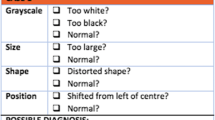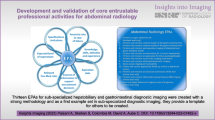Abstract
Increasingly, constructive thought is being given to non-interpretive competencies in Radiology training and practice. Two of these are “Practice-Based Learning” and “Systems-Based Practice”. These areas are evolving. It seems likely that, in some way, the paradigm of “Evidence-Based Practice” (EBP) derived from the McMaster/Centre for Evidence-Based Medicine (CEBM) methodology will form part of these new disciplines. This introductory article sets the scene for this Feature Section in Abdominal Imaging consisting entirely of short “Critically Appraised Topics” produced using EBP techniques. It is hoped that this will stimulate further discussion and consideration of the potential role of EBP in radiology education.
Similar content being viewed by others
References
Smith GCS, Pell JP (2003) Parachute use to prevent death and major trauma due to gravitational challenge: systematic review of randomized controlled trials BMJ 327:1459–1461
Staunton M, Malone DE (2007) Evidence-based practice in radiology. Step 5 (evaluate); caveats, common questions. Radiology 243(2):319–328
Sackett DL, Rosenberg WM, Muir Gray JA, et al. (1996) Evidence-based medicine: what it is and what it isn’t. BMJ 312:71–72
Sox HC (2007) Preface to the 1988 first edition. In: Sox HC, Blatt MA, Higgins MC, Marton KI, (eds). Medical decision making. Philadelphia: American College of Physicians, p IX
Welch HG, Lurie JD (2000) Teaching evidence-based medicine: caveats and challenges. Acad Med 75:235–240
Staunton M (2007) Evidence-based radiology: steps 1 and 2-asking answerable questions and searching for evidence. Radiology 242:23–31
Dodd JD (2007) Evidence-based practice in radiology: steps 3 and 4-appraise and apply diagnostic radiology literature. Radiology 242(2):342–354
Maher MM, Hodnett PA, Kalra MK (2007) Evidence-based practice in radiology: steps 3, 4-appraise and apply interventional radiology literature. Radiology 242:658–670
Halligan S, Altman D (2007) Evidence-based practice in radiology: steps 3 and 4-appraise and apply systematic reviews and meta-analyses. Radiology 243(1):13–27
Wood BP (1999) What’s the evidence? Radiology 213:635–637
The Evidence-Based Radiology Working Group. (2001) Evidence-based radiology—a new approach to teaching the practice of radiology. Radiology 220(3):566–575
Collins J, de Christenson MR, Gray L, et al. (2002) General competencies in radiology residency training: definitions, skills, education and assessment. Acad Radiol 9:721–726
Van Beek ERJ, Malone DE (2007) Evidence-based practice in radiology: why and how should we teach it? Radiology 243(3):633–640
Author information
Authors and Affiliations
Corresponding author
Rights and permissions
About this article
Cite this article
Malone, D.E. Evidence-based practice in radiology: what color is your parachute?. Abdom Imaging 33, 3–5 (2008). https://doi.org/10.1007/s00261-007-9311-4
Published:
Issue Date:
DOI: https://doi.org/10.1007/s00261-007-9311-4




